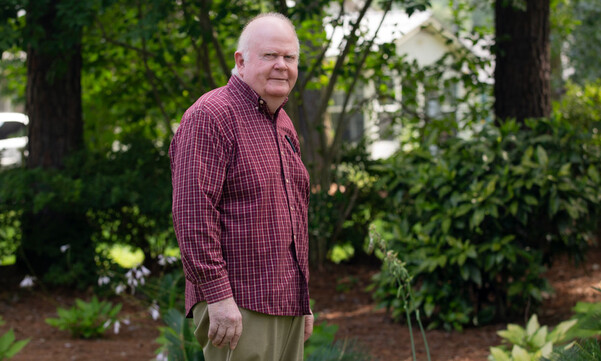Kendra Gerlach was used to chronic headaches; she’d had them since childhood. In May 2022, the 50-year-old, Richmond, VA resident experienced a headache so excruciating that she went to her local emergency room. After learning she had a structural brain defect called a Chiari malformation that was contributing to a build-up of cerebrospinal fluid (CSF) in her brain, Gerlach sought care at Duke Health. Six months after minimally invasive surgery to restore CSF circulation, Gerlach’s headaches are shorter, less frequent, and less painful. “God led us to the right surgeon and to the right place at Duke,” she said.
Excruciating Headache Signals CSF Build-Up
The headache that landed Gerlach in the ER “was unlike any other headache I’ve had before,” she said. “I could feel the pain start at the base of my neck and move all the way up to the front of my head.” The relentless pounding put Gerlach on the floor, as she called to her husband for help.
ER doctors gave Gerlach a cocktail of migraine drugs, but they barely dulled the pain. A CT scan revealed ventriculomegaly -- enlarged ventricles or spaces in the brain that circulate CSF. A local neurosurgeon also discovered Gerlach had brain tissue extending into her spinal canal, a condition known as a Chiari malformation that Gerlach may have been born with. Chiari malformations can contribute to hydrocephalus, a build-up of CSF (which normally nourishes and protects the brain), and can cause ventriculomegaly, headaches, and other problems.
Choosing the Right Treatment
Gerlach’s local doctors suggested surgically placing a permanent tube called a shunt into her brain to drain the excess CSF. Gerlach knew shunts have high complication rates. She sought a second opinion from Gerald Grant, MD, a Duke neurosurgeon who specializes in treating Chiari malformations and other CSF conditions.
After a series of tests, Dr. Grant discovered a blockage in Gerlach’s CSF circulation system in addition to her Chiari malformation. This blockage, known as aqueductal stenosis, is a common cause of hydrocephalus. Instead of a shunt, Dr. Grant recommended an endoscopic third ventriculostomy (ETV). While the minimally invasive procedure is commonly used to treat children with hydrocephalus, neurosurgeons are less likely to offer it to adults because the condition is less common in adults, said Dr. Grant, who treats both children and adults.
“During ETV, we make a little hole underneath the brain to connect the third ventricle with the rest of the spinal fluid and bypass the blockage so the fluid can circulate,” he said. “We believed the ETV procedure would reduce her hydrocephalus, and that would cause her Chiari symptoms to improve without having to do a bigger operation.”
A Merry Recovery
After the short surgery and a two-night hospital stay, Gerlach was discharged on Christmas Eve 2022. “It was a different kind of Christmas for our family. But we felt like our best Christmas gift of all was coming through a procedure like this,” Gerlach said.
Today, Gerlach is back to exercising, house remodeling, and other things she had put on hold before her surgery. Follow-up imaging shows Gerlach’s ventricles are shrinking, her CSF is circulating, and her symptoms are improving. She still gets headaches, but “when they happen, they are shorter and less intense,” Gerlach said. “I used to have headaches that would last for days, but they don’t happen that way anymore.”
Dr. Grant encourages people with Chiari malformations to seek care at a center like Duke, where experts have the skill and experience to offer advanced care. Gerlach is glad that she did. “For me, my tiny scar is a permanent reminder of what I’ve been through and what we’ve overcome. It makes me very thankful that we found the right physician and the right place. I’ve had an amazing outcome because of it.”




